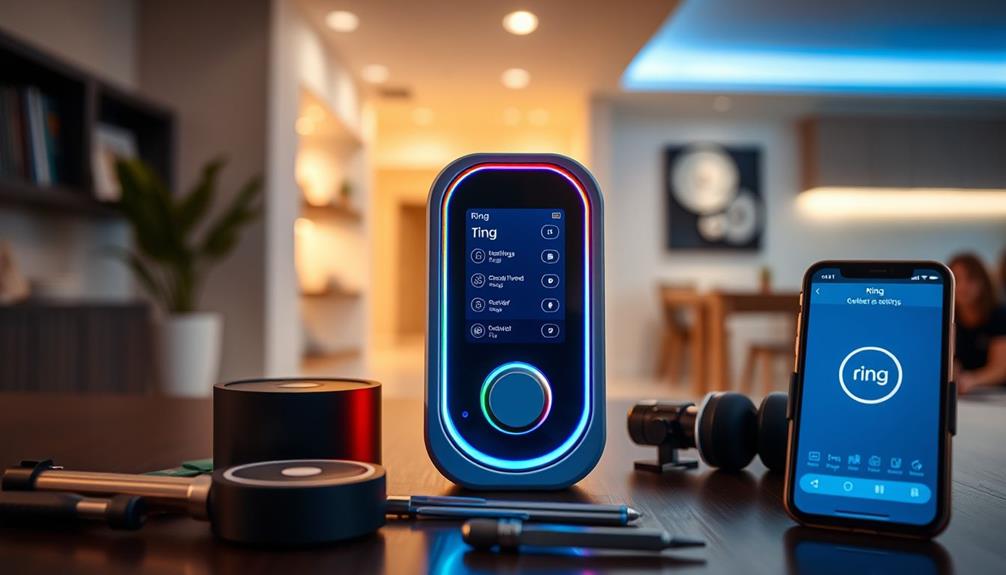To ensure your Ring Doorbell rings inside, start by checking if your specific model is compatible with in-home chimes. If you have a hardwired model, confirm that it is properly connected to your existing doorbell circuit. Utilize the Ring app to activate Automatic Chime Detection or manually adjust chime settings in the Advanced Settings section. For those using a battery-powered model, consider adding a Ring Chime or Chime Pro for indoor alerts. Once you have made these changes, test the doorbell to ensure it now rings inside. Stay tuned for additional helpful tips and troubleshooting steps.
Key Takeaways
- Verify your Ring Doorbell model for compatibility with internal chimes using the Ring app settings.
- For hardwired models, ensure proper wiring and transformer output between 8V to 24V.
- Enable Automatic Chime Detection in the Ring app during setup to connect to in-home chimes.
- If automatic detection fails, manually configure chime settings in the app under Advanced Settings.
Understanding Ring Doorbell Models
To effectively understand your Ring doorbell model, it's vital to recognize the differences between battery-powered and hardwired options.
Battery-powered Ring doorbells, such as the Ring Video Doorbell, don't connect to internal chimes. This means you'll only hear the chime outside unless you add a Ring Chime or Chime Pro for indoor alerts.
For a more immersive audio experience similar to home theatre setups, hardwired Ring devices like the Video Doorbell Pro and Wired Doorbell connect directly to your existing doorbell circuits.
When hardwiring Ring devices, you may need to bypass any mechanical chimes to guarantee functionality.
Each model has specific compatibility requirements for internal chimes, so it's important to identify your exact Ring Doorbell model. You can easily do this through the Ring app, which provides tailored setup instructions and compatibility information.
Understanding these differences will help you choose the right solution for ringing inside your home.
Make sure to reflect on whether you want the convenience of battery power or the reliability of hardwiring, as this choice greatly impacts how your Ring doorbell interacts with any compatible chime you might want to use.
Connecting to In-Home Chimes

Connecting your Ring Doorbell to in-home chimes enhances your experience by guaranteeing you hear alerts inside your home when someone rings the doorbell.
This connection not only improves convenience but also strengthens celebrating family bonds by keeping you informed about visitors.
To get started, make certain your Ring Doorbell is compatible with your existing in-home chime, which includes models like the Video Doorbell (2nd Gen), 3, 3 Plus, 4, Battery Doorbell Plus, and Battery Doorbell Pro.
Use the Ring app to enable Automatic Chime Detection during the initial setup.
This feature allows your Ring Doorbell to identify and connect to your in-home chime automatically.
If it doesn't connect, don't worry; you can manually configure the chime settings in the app by finding your way to Advanced Settings and selecting the appropriate Chime Type.
For hardwired models like the Wired Doorbell Plus and Wired Doorbell Pro, verify you have proper wiring to allow the internal chime to function correctly.
If you're using battery-powered models that don't support internal chimes, consider adding a Ring Chime or Chime Pro to receive audible notifications around your home.
With these steps, you'll guarantee you never miss a visitor again.
Automatic Chime Detection Process

Enabling Automatic Chime Detection in the Ring app allows your doorbell to easily find and connect to your in-home chime. To get started, open the Ring app and access the menu for your device settings. From there, select your doorbell from the list, and navigate to the In-home Chime Settings section. This is similar to how essential kitchen gadgets enhance functionality in cooking by seamlessly integrating tools into your workflow.
Once you're in the right spot, simply turn on the Automatic Chime Detection feature. This prompts the app to identify any existing chime connected to your doorbell. Follow the on-screen prompts to test the chime functionality and confirm that it rings inside your home. You'll want to guarantee that everything's working correctly so you never miss a visitor.
If the detection process doesn't succeed on the first try, don't worry. You can easily restart the auto-detection process to attempt again. This feature makes it simple to guarantee that your Ring doorbell communicates effectively with your in-home chime, providing a seamless experience when someone rings your doorbell.
With just a few steps, you'll have your chime ringing in no time.
Manual Chime Configuration Steps

Accessing the Ring app and steering to your doorbell's device settings is the first step to manually configure your chime. Once you're in the app, select "Advanced Settings" to find the chime configuration options. Here, you'll see a list of available "Chime Types." Choose the one that matches your existing chime setup.
After selecting the appropriate chime type, wait a few moments for the app to update the settings. Then, press the doorbell button to check if the internal chime rings as expected. If it doesn't, revisit your chime type selection.
Here's a quick reference for different chime configurations:
| Chime Type | Description |
|---|---|
| Mechanical Chime | Traditional chime with a hammer |
| Digital Chime | Electronic sound without a hammer |
| Wireless Chime | Battery-operated and portable |
| Custom Chime | User-defined sounds and tones |
Troubleshooting Common Issues

If your Ring doorbell isn't ringing inside, you might need to check a few key factors.
Start by ensuring your chime is compatible and double-check your wiring connections.
Check Chime Compatibility
To verify your Ring Video Doorbell works seamlessly with your existing chime, check its compatibility by consulting the list of supported chime types in the Ring app or on the Ring website. This is vital because not all doorbell chimes will work with your device, especially if you have a hardwired model or a mechanical chime.
Here are some key points to remember:
- Check if your chime is supported: Some chimes may not function correctly with your Ring doorbell.
- Consider using a Ring Chime: If you have a battery-powered doorbell, you won't hear internal chimes, so a Ring Chime enhances your indoor notifications.
Don't forget to check your Ring app settings to confirm the chime is linked correctly and that notifications are enabled.
Verify Wiring Connections
Verify the wiring connections to confirm they're securely attached, as loose wires can stop your Ring Video Doorbell from receiving power and signaling the internal chime.
Start by checking the connections at the back of the doorbell to confirm none are loose or disconnected.
Next, inspect the transformer supplying power to the doorbell; it should output between 8V to 24V AC. Insufficient voltage can hinder your chime's functionality.
Also, take a moment to review your chime kit for compatibility with the Ring Video Doorbell. Not all mechanical chimes will work seamlessly, so confirm that yours is on the approved list.
If necessary, verify that the chime kit is properly wired, and any bypassing of mechanical chimes has been done according to the installation requirements.
Adjust Notification Settings
Adjusting your notification settings in the Ring app can resolve common issues that prevent your doorbell from ringing inside. Start by ensuring that your hardwired Ring doorbell is properly connected to a compatible in-home chime.
Follow these steps to adjust your settings:
- Open the Ring app and navigate to Device Settings.
- Check that the Linked Chimes option is enabled for your doorbell.
If your doorbell still isn't ringing, verify the wiring connections and make sure your transformer provides adequate power.
You can also try adjusting the Chime Type in the app's Advanced Settings. Test the functionality by pressing the doorbell button to see if your internal chime rings.
Resources for Additional Support

When you're facing challenges with your Ring Doorbell's internal chime, several resources are available to help you troubleshoot and resolve the issue.
Start by accessing the Ring app, where you'll find user manuals and troubleshooting guides tailored for your specific device. These guides can be invaluable for understanding how to connect your Ring Doorbell to internal chimes, including the Ring Chime Pro.
If you need more detailed assistance, visit the Ring Help Center. Here, you can explore a variety of articles categorized by product, which cover installation and troubleshooting for internal chimes. Additionally, the FAQs section offers quick answers to common questions that might save you time.
For real-world experiences and advice, consider engaging with the Ring Community platform. It's a great space to share your challenges and receive insights from other users.
If you still can't resolve the issue, don't hesitate to reach out to Ring customer support for personalized assistance. They're equipped to handle any unresolved problems you might encounter with your doorbell's internal chime functionality.
Frequently Asked Questions
Why Is My Ring Doorbell Not Ringing Inside My House?
If your Ring Doorbell isn't ringing inside, check a few key things.
First, make certain you've set up a compatible Ring Chime or Chime Pro, as these are necessary for indoor alerts.
Next, verify your Ring app settings to guarantee internal chime notifications are enabled.
If you have a wired model, confirm it's properly connected to your home's power supply.
Does Ring Doorbell Ring Existing Bells?
Imagine a charming little bell chiming as you greet guests at your door.
Your Ring Doorbell can indeed harmonize with existing bells, but it depends on the model and wiring.
If you've got a hardwired Ring, it can ring your mechanical or digital chimes, provided they're compatible.
Battery-powered models, however, need a special companion like a Ring Chime or Echo device to fill your home with delightful alerts.
How to Set up Ring Doorbell Chime?
To set up your Ring Doorbell Chime, start by ensuring you have a compatible model, like the Ring Chime or Chime Pro.
Open the Ring app and navigate to your doorbell's device settings.
Enable "In-home Chime Settings" for Automatic Chime Detection.
If it doesn't work automatically, go to "Advanced Settings" to select your chime type manually.
Why Won't My Blink Doorbell Ring Inside?
Imagine it's the 1800s; you're waiting by the door for guests, but they never knock.
If your Blink Doorbell isn't ringing inside, check the chime setup in the Ring app first.
Make sure it's linked properly. If the power supply's weak or the wiring's off, that could be the issue too.
Enable Automatic Chime Detection, restart your doorbell, and run the detection again to see if it connects.
Conclusion
Incorporating your Ring Doorbell with your in-home chimes can be as seamless as a perfectly tuned orchestra.
By understanding your doorbell model and following the right steps, you can guarantee that every visitor gets the warm welcome they deserve.
If you run into any hiccups, don't hesitate to troubleshoot or seek additional support.
With a little patience and the right guidance, your home can resonate with the delightful sound of your doorbell ringing inside.









